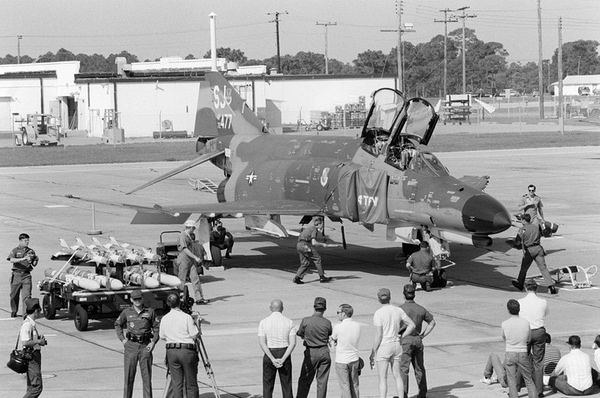National Reconnaissance Program crisis photography concepts, part 3: Axumiteby Joseph T. Page II
|
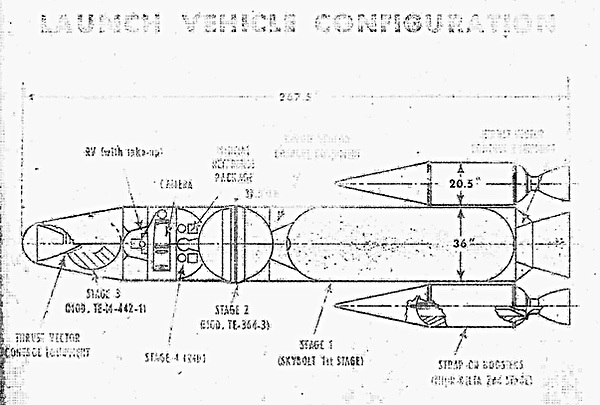 Axumite Launch Vehicle Configuration. (credit: NRO) |
Rapid response satellite launch platform
The Axumite concept focused on quick reaction from a photographic satellite system launched from an F-4 aircraft launched from a Pacific air base.[2] After a short trip to orbit, the satellite-borne camera would execute an orbital path with for a one-time target coverage and re-enter over either the Pacific or Atlantic Ocean, with the film whisked away for imagery processing on the West or East Coast respectively.[3]
Previous systems covered in this series (Corona Six-Pack, Pinto) relied upon proven space launch vehicles that were previously adapted by the NRP, such as the Atlas-F intercontinental ballistic missile (ICBM). These system concepts inherited the limiting factors based upon the choice of booster, such as launch processing timelines for the Atlas-F and pad location at Vandenberg AFB, California.
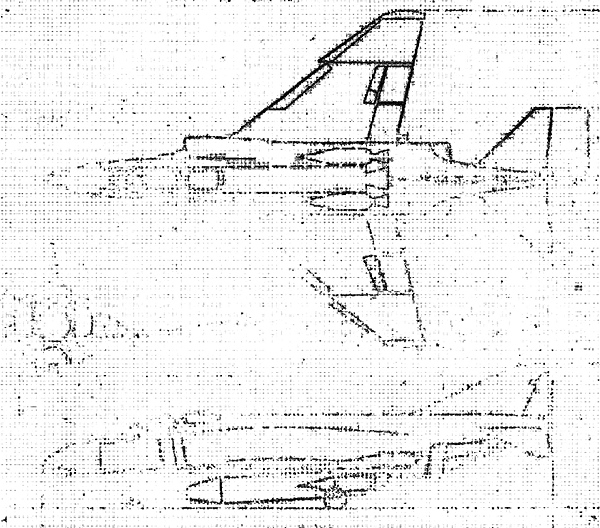 Proposed carriage of Axumite launcher on an F-4 Phantom II. (credit: NRO) |
Using an aircraft as a satellite launcher altered these planning considerations to ones inherent to the platform, namely lift capacity, range distances, and bed down locations. The NRO and CIA had previously investigated the idea of using an SR-71 aircraft as a satellite launcher in 1962, but ultimately abandoned the concept. (see “Blackbirds and black satellites: the A-12 OXCART as a satellite launcher,” The Space Review, January 3, 2022.)
| Axumite’s design relied upon proven hardware from a variety of US launch platforms, from the reliable to the obscure to even cancelled ones. |
These considerations, however, were well understood within the paradigm of rapid response for crisis reconnaissance as other platforms within the NRP—such as the SR-71, U-2, and D-21—had been used for this mission for many years. Axumite’s design augmented these systems by boosting the camera and film above the atmosphere and maintaining the launching aircraft outside of the engagement envelope of threat missiles and radars, while also bringing the photographic imagery back to national leaders within hours.
The Phantom
Axumite’s planned satellite launcher, the McDonnell Douglas F-4 Phantom II, was originally developed for the US Navy for fleet defense and later adopted by the US Air Force for both air-to-air and air-to-ground (bombing) roles. With more than 5,000 airframes manufactured by McDonnell Douglas from 1958 through the late 1970s, and the aircraft’s prominent role during the Vietnam War, F-4 operations were well integrated into airbases around the world, providing readily available take-off locations, and operational security (OPSEC) considerations with the ubiquitous platform.
Franken-rocket
As designed, the Axumite launch vehicle consisted of a four-stage rocket, with solid strap-on rockets for thrust augmentation. Based upon the documentation released by the NRO, Axumite’s design relied upon proven hardware from a variety of US launch platforms.[3] Pieces of the launch vehicle, as shown in the table, were selected from programs ranging from the reliable (Thor-Delta, STAR upper stage series), to the obscure (the Apollo RCS thruster), and even cancelled ones (the Skybolt missile).
| Strap-On | Stage 1 | Stage 2 | Stage 3 | Stage 4 | |
|---|---|---|---|---|---|
| Motor | Thor-Delta 2nd Stage | Skybolt 1st Stage | STAR-37D (TE-M-364-3) | STAR-26B (TE-M-442-4) | R-4D |
| Fuel- | Solid | Solid | Solid | Solid | Liquid |
| Weight | 9000 | 2625 | 900 | 260 | Variable |
The reliable Thor-Delta series provided Axumite’s strap-on rockets for thrust during initial launch; one other Axumite-related document stated these solid motors from SLV-1 Scout rockets. The GAM-87 Skybolt (retroactively designated AGM-48) was an air-launched ballistic missile (ALBM) designed to provide quick reaction nuclear delivery during crisis situations. Ultimately Skybolt was cancelled during the Kennedy Administration with the advent of the SM-80 (later LGM-30) Minuteman ICBM. The Skybolt program was cancelled on December 22, 1962, with the last missile launched the next day on December 23, presumably leaving plenty of spare Skybolt parts around for reuse within Axumite.
Use of the R-4D is curious from a space history perspective. The Apollo Service Module used four R-4D thrusters in each reaction control system (RCS) quad setup around the spacecraft, using nitrogen tetroxide and monomethyl hydrazine as hypergolic fuel.
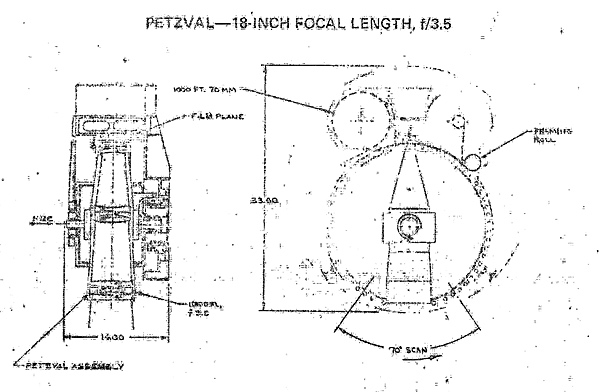 Proposed 18-inch Petzval Lens design. (credit: NRO) |
Camera requirements
Axumite’s characteristics, as shown in the NRO files, are based on camera requirements, unlike the specifically identified optical systems within the Corona Six-Pack or PINTO concepts. One document states Axumite’s camera “…would be a 32-inch focal length scaled up version of the CORONA camera yielding three-foot resolution at 75 nautical miles.”
| At this point during the NRO’s development timeline, rapid retrieval of imagery was seemingly more critical than ground resolved distance. |
At the time of Axumite’s development, Corona had flown the Corona-M/MURAL (KH-4), J-1 (KH-4A), and J-3 panoramic camera (KH-4B), so it is unclear which camera version was being referenced. These Itek-designed cameras (and the earlier C Triple Prime) all used a 24-inch (61-centimeter) Petzval lens (f/3.5). However, the reproduced Axumite camera specification shows a modified 18-inch (46-centimeter) Petzval as a minimum focal length, likely indicating that the camera chosen was not government “off-the-shelf” (GOTS) equipment from the NRP. To add to the confusion, the Axumite briefing included six candidate camera parameters, along with five listed within an order of preference.
Axumite’s camera objectives stated an estimated Ground Resolved Distance (GRD) of 5–7 feet (1.5–2.1 meters), greater than the KH-4B Corona satellites flying around that time, but less than the KH-7 Gambit or KH-8 Gambit-3. However, the “White Paper on Crisis Reconnaissance” provided metric bookends to the usefulness of rapidly obtained imagery:
“Two to three-foot ground resolution distance. [Redacted] twelve-inch GRD may be required for tactical utility. In some cases, GRD up to 15 feet may be useful.” [6] [Emphasis added]
At this point during the NRO’s development timeline, rapid retrieval of imagery was seemingly more critical than GRD. But one can wonder if the inversely proportional trade-off between “fast” [processing] and “better” [resolution] was worth the less-refined pictures one would obtain more rapidly.
Axumite’s designers, however, recognized the engineering adage of “Better is the enemy of good enough,” when declaring “Best resolution obtainable within resource constrains is desired.”
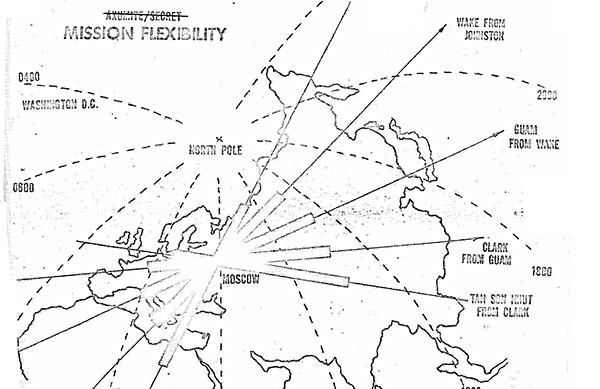 Mission Coverage from Specified Launch Locations. (credit: NRO) |
Location, location, location
Due to the launcher aircraft’s requirement to recover at a land-base after launch and specific orbital inclinations required for target coverage, only a handful of US-controlled airbases fit the bill.[4] With a posigrade (eastward launch) between 65- and 75-degrees inclination, the entire Eurasian continent was accessible during the low Earth circular orbit from the following proposed launch locations[8]:
- Hawaii (likely Hickam Air Force Base)
- Johnston Island
- Wake Island
- Guam
- Okinawa
Orbital considerations required the system to dump itself into the ocean if it suffered any catastrophic failure, to prevent re-entry over the Soviet Union or People’s Republic of China. Inclination constraints were based on both launch and recovery locations, allowing the target to be photographed on the first, second, or third revolution (no later), allowing a re-entry recovery from any of the five launch locations within a maximum of five revolutions. Not all bases could support recovery from other specific locations, and no base could support a launch-and-recovery at their own location based on the Earth’s rotation rate during the elapsed mission time.
Recovery forces were not identified but would presumably use assets from the 6594th Test Group, the NRO’s go-to organization for mid-air capsule snatching. Many of the same considerations analyzed for recovery of the PINTO system, such as extreme weather (e.g. hurricanes), film processing times, and location of recovery forces, would similarly affect Axumite’s recovery operations. (see “National Reconnaissance Program crisis photography concepts, part 2: PINTO”, The Space Review, February 6, 2023)
| Review of the information provided by the NRO leaves many questions unanswered, with an uneasy feeling that the concept was more half-baked than the diagrams and charts show. |
Critical planning considerations for crisis reconnaissance photography included the ability to get the images back to Earth, processed, and into the hands of national leadership. Aside from generally mentioning the Atlantic and Pacific recovery locations, no specific processing locations were identified. The National Photographic Interpretation Center (NPIC) or Westover AFB’s Air Force Special Projects Production Facility were likely candidates for East Coast processing, along with the Overseas Processing and Interpretation Center – Asia (OPIC-A).[5]
A few years later—based on no active NRP missions in either hemisphere requiring dedicated support—the NRO bowed out of supporting the OPIC facilities in Asia and Europe altogether.[5] Whether this disengagement of OPIC support was a fait accompli during the development of these rapid-response concepts (Axumite, Pinto, Fastback) is unknown.
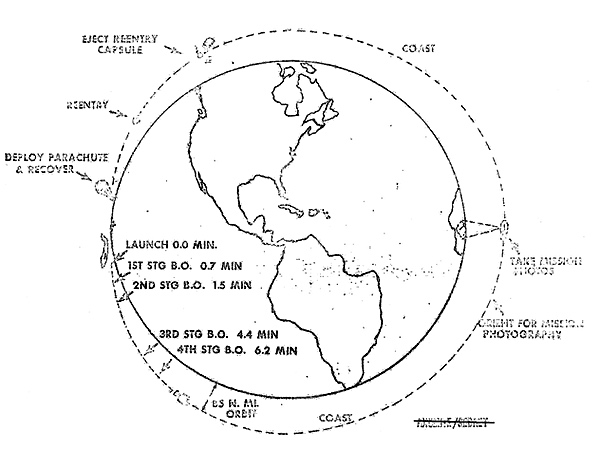 Axumite’s Orbital Timeline. (credit: NRO) |
Axumite’s abortive attempt
From the paltry documentation within NRO records, there apparently was no appetite for the Axumite concept. Some of the previously mentioned quick reaction capabilities offered to the NRP in the early 1970s illustrate innovative in situ thinking on the part of planners during the period. The Axumite system shows an extension of this thinking, with planners pulling the most responsive pieces of various weapon systems to get a rocket and its camera and film payloads into orbit within minutes of notification.
Review of the information provided by the NRO leaves many questions unanswered, with an uneasy feeling that the concept was more half-baked than the diagrams and charts show. If additional Axumite material remains within Boeing’s archives (inheriting McDonnell Douglas’ legacy) or the NRO’s Archival Research Center (NROARC), more questions may be answered in the future.
While Dr. Naka’s “eye-opening” look covering these potential systems for crisis situations got the attention of the State Department staffers, Cline was not convinced. Financial considerations, technological effort, and lessening return on investment from film-based systems kept Cline’s attention on the “real-time readout system,” later described as the electro-optical imaging (EOI) system (Zaman/Kennen). Even Naka’s reassurances on the capabilities of the KH-9 Hexagon—scheduled for a 1971 launch—did not sway Cline, who worried about the authorities attached to Hexagon’s “call down” (re-entry vehicle return) capability, citing the bureaucratic complexity in making and executing such a decision. In his mind, Cline saw EOI as the only way to go for the State Department’s intelligence needs.
Notes
- Naka, F. Robert. “Memo. Subject: Approval of ExCom Minutes (ExCom-M-24).” 18 February 1971. NRO FOIA For All.
- Sweeney, Edwin. “Memorandum for Dr. McLucas. Subject: State Department Briefing.” 4 November 1970. NRO FOIA For All.
- No Author. “Axumite Briefing Summary.” No date. NRO FOIA For All.
- No Author. Point Paper. “Should the NRO acquire an interim sys with improved response time prior to EOI?” No date. NRO FOIA For All.
- Kulpa, John. “Memo. Subject: Overseas Processing and Interpretation Centers (OPICs).” 19 April 1973. NRO Staff Records Collection.
- No author. “White Paper on Crisis Reconnaissance.” No date. NRO Archives. 2022 Sunshine Week Releases.
- Regarding the image quality, the diagrams came from the referenced material in the links below. Blame the NRO’s scanner or carbon copies.
- Clark Air Base, Philippines is mentioned briefly on one target coverage chart, but no other amplifying information was listed within the presentation, leading to a conclusion Clark was not a serious contender for Axumite.
Note: we are now moderating comments. There will be a delay in posting comments and no guarantee that all submitted comments will be posted.
